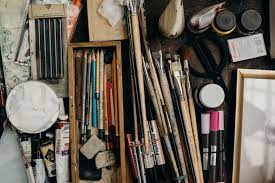Tools to Create Art

Drawing Tools:
Pencils: Essential for sketching and drawing, pencils come in various hardness levels (ranging from 9H to 9B) that allow for different line weights and shading techniques.
Charcoal: Ideal for creating dramatic, expressive drawings, charcoal sticks and pencils produce rich, dark marks that can easily be smudged and blended.
Ink Pens: Used for precise and detailed line work, ink pens offer control and consistency. They are popular among illustrators, comic artists, and graphic designers.
Pastels: Soft pastels and oil pastels provide vibrant colors and a unique texture. They can be blended with fingers or tools to achieve various effects.
*Drawing Tools are a great starting point. Pencils are easy to find. This is also a very popular starting point in schools due to the price point and lack of mess.
Painting Tools:
Brushes: Available in different sizes, shapes, and bristle types, brushes are a fundamental tool for painting. They allow for controlled application of paint and can create a range of textures.
Palette: Used for mixing and organizing colors, a palette can be made of plastic, glass, or wood. It provides a flat surface where artists can blend and experiment with different hues.
Paints: Depending on your preference and medium, there are various types of paints to choose from, such as acrylics, oils, watercolors, or gouache. Each has its unique characteristics and techniques.
Palette Knife: This tool has a blunt, flexible blade that can be used to apply and manipulate paint on a canvas. Palette knives create textured and impasto effects.
*I would start with acrylic or water colors when starting out in the painting world. Oil not only takes months to dry, it also requires chemicals to clean the brushes after use.
Digital Art Tools:
Graphics Tablet: A graphics tablet, paired with a stylus, allows artists to create digital artwork directly on a computer. It provides pressure sensitivity and precise control over brush strokes.
Digital Drawing Software: Programs like Adobe Photoshop, Corel Painter, or Procreate offer a wide range of digital brushes, layers, and editing capabilities, providing a virtual canvas for digital artists.
3D Modeling Software: For artists interested in creating three-dimensional art, software like Blender, ZBrush, or Maya enables the creation of digital sculptures and intricate 3D designs.
*in today's age, having experience using any of these programs to create is always a great point on any resume.
Sculpting Tools:
Clay and Modeling Compounds: Artists working with clay or other modeling compounds require tools such as sculpting knives, wire tools, loop tools, and shaping tools to mold and shape their creations.
Pottery Wheel: Essential for pottery and ceramics, a pottery wheel allows artists to shape clay while it spins. It requires skill and practice to create symmetrical and balanced pieces.
Carving Tools: Wood carving, stone carving, or even carving fruits and vegetables require specialized tools like chisels, gouges, and mallets to remove material and create intricate details.
*With this medium, I definitely recommend starting in a class. Not to mention having to have the wheel for the clay is a commitment with cost. Many junior colleges offer enrichment classes, and clay is usually one of them.
Printmaking Tools:
Carving Tools: Used in relief printmaking techniques like linocut or woodcut, carving tools help artists create designs by cutting away material from a block.
Printing Press: Traditional printmaking techniques often involve a printing press, which applies pressure to transfer ink from the carved block onto paper or fabric, resulting in multiple identical prints.
Photography Tools:
Camera: Depending on your preference, a digital camera or film camera can be used to capture photographs. Consider factors like resolution, lens options, and manual controls to suit your style.
Tripod: A sturdy tripod helps stabilize the camera and allows for precise composition, especially in low light conditions or when using long exposures.
Editing Software: Programs like Adobe Lightroom or Photoshop enable photographers to enhance and manipulate their images, adjusting colors, contrast, and other elements.
Mixed Media Tools:
Collage Materials: Artists working with collage may use a variety of materials like papers, fabrics, photographs, found objects, and adhesive mediums to create layered and textured compositions.
Cutting Tools: Scissors, craft knives, and paper trimmers are essential for cutting and shaping materials in mixed media artwork.
Adhesives: Depending on the medium, artists may need various adhesives such as glue sticks, double-sided tape, or gel mediums to adhere materials together.
Remember, these are just a few examples of the tools available to artists. The choice of tools ultimately depends on your preferred medium, style, and personal preference. Don't be afraid to experiment, explore new tools, and find what works best for you. Art is a journey of self-expression, and the tools you choose are the instruments that help bring your vision to life. And always check for beginners classes, sometimes just taking the class will quickly tell you if you love or hate that medium.

